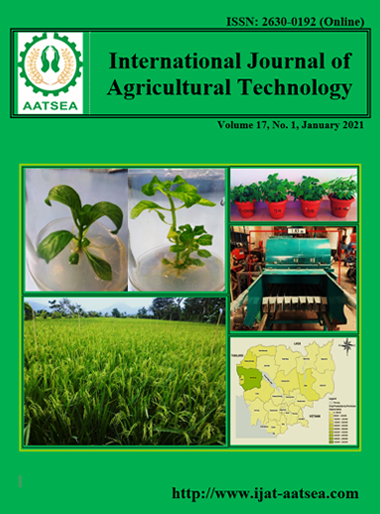Antifungal potential of some essential oils as a fumigant against a stored grain fungus, Aspergillus flavus
Main Article Content
Abstract
The 20 essential oils extracted from different angiospermic plants, Agele marmelos (L) Correa, Ageratum conyzoides L., Allium sativus,. Ammomum subulatum Roxb. Anethum graveolens L., Caesuliaaxillaris Roxb,. Callistemon lanceolatus DC., Chenopodium ambrosioides L., Cinnamomumcamphara L., Cinnamomumcamphara L., Citrus reticulate Blanc,. Citrus sinensis L., Curcuma longa L. Koenig, Cymbopogan citrates DC., Elettaria cardamomum Maton., Eucalyptus citriodera Hook., Eupatorium cannabinum L., Foeniculum vulgare Mill., Trachyspermum ammi L., Zingiber officinale were tested to screen against Aspergillus flavus. Among them, the maximum percent mycelial inhibition was recorded with Chenopodium and Trachyspermum oils. Further physico-chemical properties of these two essential oils were identified by using GLC. MIC of Chenopodium and Trachyspermum essential oils at 100-400 ppm actively against A. flavus (post harvest fungus) which proved to be fungistatic and fungicidal effects as control mechanism. It would be developed to be potential as post-harvest fumigants.
Article Details

This work is licensed under a Creative Commons Attribution-NonCommercial-NoDerivatives 4.0 International License.
References
Bomfim, N. d. S., Kohiyama, C. Y., Nakasugi, L. P., Nerilo, S. B., Mossini, S. A. G., Romoli, J. C. Z. R., Mikcha, J. M. G., Filho, B. A. de A. and Machinski Jr M. (2020). Antifungal and antiaflatoxigenic activity of rosemary essential oil (Rosmarinus officinalis L.) against Aspergillus flavus. Food Additives and Contaminants: Part A, 37:153-161.
Bosquez-Molina, E., Ronquillo-de Jesús, E. BautistaBanos, S., Verde-Calvoa, J. R. and Morales-López, J. (2010). Inhibitory effect of essential oils against Colletotrichumgloeosporioides and Rhizopusstolonifer in stored papaya fruit and their possible application in coatings. Postharvest Biology and Technology, 57:132-137.
Bull, C. T., Stack, J. P. and Smilanick, J. L. (1997). Pseudomonas syringae strains ESC-10 and ESC-11 survive in wound on citrus and control green and blue molds of citrus. Biological Control, 8:81-88.
Burt, S. (2004). Essential oils: Their antibacterial properties and potential applications in foods-a review. International Journal of Food Microbiology, 94:223-253.
Dube, S., Upadhyay, P. D. and Tripathi, S. C. (1989). Antifungal, physic-chemical and insect repellent activity of essential oil of Ocimumbasilicum. Canadian Journal of Botany, 67:2085-2087.
Dubey, N. K. (2000). Bioprospecting-option for India. Current Science, 78:369-370.
Kumar, R., Mishra, A. K., Dubey, N. K. and Tripathi, Y. B. (2007). Evaluation of Chenopodium ambrosioides oil as a potential source of antifungal, antiaflatoxigenic and antioxidant activity. International Journal of Food Microbiology, 115:159-164.
Kumari, A., Kumar, R., Maurya, S., Chowdhary, J. S. and Kumar, S. (2013). Antifungal efficacy of aquous extracts of Neem cake, karanj cake and vermicompost against some phytopathogenic fungi. The Bioscan, 8:671-674.
Miri, Y. B., Belasli, A., Djenane, D. and Ariño, A. (2019). Prevention by Essential Oils of the Occurrence and Growth of Aspergillus flavus and Aflatoxin B1 Production in Food Systems: Review. DOI: http://dx.doi.org/10.5772/intechopen.88247
Mishra, A. K. and Dubey, N. K. (1994). Evaluation of some essential oils for their toxicity against fungi causing deterioration of stored food commodities. Applied and Environmental Microbiology, 60:1101-1105.
Poppe, L., Vanhoutte, S. and Höfte, M. (2003). Modes of action of Pantoeaagglomerans CPA-2, an antagonist of postharvest pathogens on fruits. European Journal of Plant Pathology, 109:963-973.
Richard, J. L., Cole, R. J. and Archibalol, S. O. (1989). Mycotoxins, economic and health risks. Council Agriculture Science Technology Report, pp.116.
Rojas, T. R., Sampayo, C. A. F., Vázquez, B. I., Franco, C. M. and Cepada, A. (2005). Study of interferences by several metabolites from Aspergillus spp. in the detection of aflatoxigenic strains in media added with cyclodextrin. Food Control, 16:445-450.
Thompson, D. P. (1989). Fungitoxic activity of essential oil components on food storage fungi. Mycologia, 81:151-153.
Tzortzakis, N. G. and Economakis, C. D. (2007). Antifungal activity of lemongrass (Cympopogoncitratus L.) essential oil against key postharvest pathogens. Innovative Food Science and Emerging Technologies, 8:253-258.


